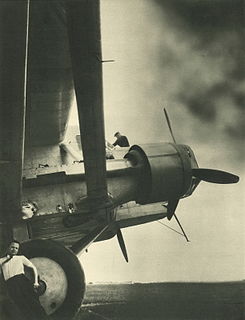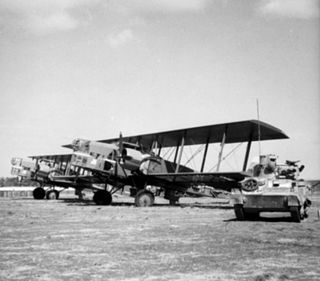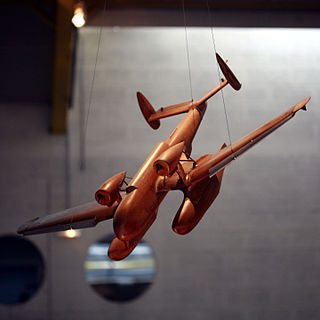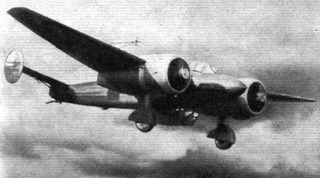
The Bloch MB.130 and its derivatives were a series of French monoplane reconnaissance-bombers developed during the 1930s. They saw some limited action at the beginning of World War II but were obsolete by that time and suffered badly against the Luftwaffe. After the fall of France, a few were pressed into Luftwaffe service.

The MB.210 and MB.211 were the successors of the French Bloch MB.200 bomber built by Societé des Avions Marcel Bloch in the 1930s and differed primarily in being low wing monoplanes rather than high wing monoplanes.

The Bloch MB.170 and its derivatives were French reconnaissance bombers designed and built shortly before the Second World War. They were the best aircraft of this type available to the Armée de l'Air at the outbreak of the war, with speed, altitude and manoeuvrability that allowed them to evade interception by the German fighters. Although the aircraft could have been in service by 1937, debate over what role to give the aircraft delayed deliveries until 1940.

The Farman F.220 and its derivatives were thick-sectioned, high-winged, four engined monoplanes from Farman Aviation Works. Based on the push-pull configuration proven by the F.211, design started in August 1925 and the first flight of the prototype was on 26 May 1932. The definitive F.222 variant was the biggest bomber to serve in France between the world wars. One variant was designed as an airliner.

The Farman F.60 Goliath was a French airliner and bomber produced by the Farman Aviation Works from 1919. It was instrumental in the creation of early airlines and commercial routes in Europe after World War I.

The Farman F.70 was a 1920s French passenger and mail transport aircraft designed and built by the Farman Aviation Works. It was a smaller counterpart to the company's popular F.60 Goliath. The F.70 was an unequal-span two-bay biplane with a wooden fuselage and was powered by a Renault 12Fe piston engine. The pilot was seated in an open cockpit behind the nose-mounted engine. Behind the open cockpit was a cabin for four passengers or freight.

The Farman F.160 was a heavy bomber aircraft developed in France in the late 1920s. It was essentially an attempt by Farman Aviation Works to modernise its tremendously successful F.60 Goliath design of the immediately postwar years. The most noticeable external difference was the larger tailfin of the new aircraft. Like its predecessor, it was a large three-bay biplane of conventional configuration with unstaggered wings of equal span. Initially conceived as a heavy night bomber, most examples built were float-equipped torpedo bombers for the Aéronautique Maritime, which operated some 40 of the F.165 variant and 200 of the F.168. One of the original F.160 night bombers was exported to Italy, and one to Japan. Plans to develop airliner versions did not progress past the prototype stage.

The Lioré et Olivier LeO 20 was a French night-bomber aircraft built by Lioré et Olivier.

The Lioré et Olivier LeO 25 was a bomber aircraft produced in France in the late 1920s.

The Farman NC.470 was a French twin-engined floatplane designed as a crew trainer for the French Navy. It was used in small numbers for both its intended role as a trainer and as a coastal reconnaissance aircraft at the start of World War II.
The Farman F.150 was a 1920s French twin-engined biplane designed by Farman as a day bomber.

The Loire-Nieuport 10 was a 1930s French prototype long-range maritime reconnaissance and combat floatplane produced by Loire-Nieuport, a joint venture between Loire Aviation and Nieuport-Delage. It was an attempt to answer the requirements for the Navy's programme Hydravion éclaireur de combat for a large floatplane capable of acting as a torpedo bomber or reconnaissance aircraft.

The Farman F.211 was a French four-seat day or night bomber designed and built by the Farman Aviation Works for the French Air Force.

The Bernard 70 was a 1920s design for a French single-seat monoplane fighter aircraft by the Société des Avions Bernard. It was not built but was developed into a racing monoplane designated the Bernard S-72,. It was further developed into single-seat fighters, the Bernard 74-01 and Bernard 74-02, although only two of the fighters were built.
The Bloch MB.480 was a French twin-engined torpedo-bomber/reconnaissance floatplane designed just before the start of the Second World War by Société des Avions Marcel Bloch. Only two were built, the French Navy deciding to use landplanes instead.
The Farman F.420 was a twin engine monoplane, built in France in the mid-1930s to compete in a government contest for an aircraft capable of fulfilling bomber, fighter and reconnaissance roles. Two prototypes were constructed but no production followed.

The SNCAC NC.4-10 was a twin-engine floatplane torpedo bomber built in France in the late 1930s. It was one of several prototypes competing for an Admiralty specification but no contracts were awarded after the military lost interest in the type.

The Blériot 111 was a French four-seat executive transport monoplane designed by André Herbemont. The first French aircraft to be fitted with a retractable landing gear, after six years development it was not ordered into production.

The SNCAC NC.510 was a twin-engine French reconnaissance, army co-operation or advanced training aircraft, built in the late 1930s. Three were built and refined but production orders were not forthcoming.

The CAMS 52 was a twin-engined floatplane torpedo-bomber. It was not ordered by the French Navy and only one CAMS 52 was completed. It first flew in the summer of 1930.

















